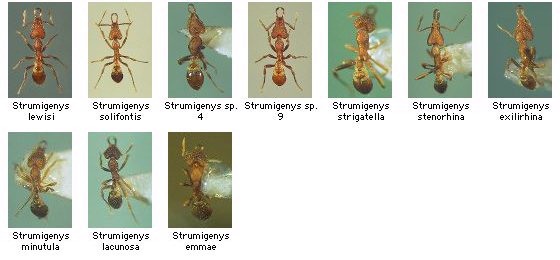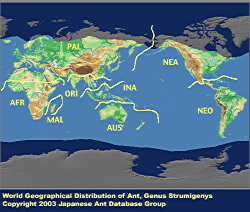
|
genus
|
Strumigenys
|
 |

|
|
Japanese Name
|
Uroko-ari-zoku
|
Original Reference
|
|
Smith, F. (1860) Descriptions of new genera and species of exotic Hymenoptera. Journal of Entomology 1: 65-84.
|
Synonym
|
|
Labidogenys Roger, 1862a,
Proscopomyrmex Patrizi, 1946,
Eneria Donisthorpe, 1948a,
Quadristruma Brown, 1949a,
|
Description
|
|
Small ants: total length of workers around 1.5 - 3.5 mm. Mandibles shaft-like, sublinear to linear, with an apical fork of 2 or 3 spiniform teeth, the dorsal tooth the longest; intercalary small denticles sometimes present. Preapical teeth on shaft numbering 0 to 2. Labrum an inverted T-shape, without forwardly-projecting lobes. Clypeus flattened. The jaw at full gape open to 170 degrees or more, and are held apart under muscular tension by the elevated clypeus. They close violently to impail prey organisms when the clypeus is lowered. Eyes situated at ventral margins of antennal scrobes. Antennae 4, 5 or 6 segmented, the 2 apical segments forming a distinct club. Propodeal spines present or absent. Vertical posterolateral infradental lamellae often present on the sides of the propodeal declivity, often with associated spongiform material. Waist segments usually with spongiform appendage. Body hairs sometimes bizarrely elaborated.
|
|

|
Remarks
|
|
Strumigenys ants are predators of small soil-inhabiting arthropods such as collembolans. Their unique mandibular structure is related to their predatory behavior (Masuko, 1984). Workerless social parasitism is known in two species (Brown, 1955; Taylor, 1968a). One Japanese species was formerly placed in genus Quadristruma, which was synonymized with Strumigenys by Bolton (1999). 466 world species were recognized by Bolton (2000). 10 species (8 scientifically named and 2 unidentified) are known from Japan.
|
References
|
|
- Roger, J. 1862. Einige neue exotische Ameisen-Gattungen und Arten. Berl. Entomol. Z., 6: 233-254.
- Patrizi, S. 1946. Contribuzioni alla conoscenza delle formiche e dei mirmecofili dell'Africa orientale. Boll. Ist. Entomol. Univ. Studi Bologna, 15: 292-296.
- Donisthorpe, H. 1948. A third instalment of the Ross Collection of ants from New Guinea. Ann. Mag. Nat. Hist., (11)14: 589-604.
- Brown, W. L., Jr. (1949b. ). Revision of the ant tribe Dacetini: III. Epitritus Emery and Quadristruma new genus (Hymenoptera: Formicidae). . Trans. Amer. Ent. Soc., 75, 43-51.
- Bolton, B. 1999. Ant genera of the tribe Dacetonini (Hymenoptera: Formicidae). J. Nat. Hist., 33: 1639-1689.
- Bolton, B. 2000. The ant tribe Dacetini part 2. Memoirs of the American Entomological Institute, 65: 492-1028.
|
Editor
|
|
Original text by Kazuo Ogata, Keiichi Onoyama and Mamoru Terayama. English translation by Kazuo Ogata, edited by Robert W. Taylor. Revised by Masashi Yoshimura.
|
|